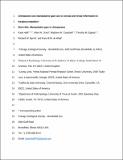Files in this item
Chimpanzee uses manipulative gaze cues to conceal and reveal information to foraging competitor
Item metadata
| dc.contributor.author | Hall, Katie | |
| dc.contributor.author | Oram, Mike W. | |
| dc.contributor.author | Campbell, Matthew W. | |
| dc.contributor.author | Eppley, Timothy M. | |
| dc.contributor.author | Byrne, Richard W. | |
| dc.contributor.author | de Waal, Frans B. M. | |
| dc.date.accessioned | 2017-11-28T00:31:45Z | |
| dc.date.available | 2017-11-28T00:31:45Z | |
| dc.date.issued | 2017-03 | |
| dc.identifier | 247649075 | |
| dc.identifier | c095ed38-d5c4-415b-b147-36b9a80e1e0b | |
| dc.identifier | 85005808180 | |
| dc.identifier | 000394651600009 | |
| dc.identifier.citation | Hall , K , Oram , M W , Campbell , M W , Eppley , T M , Byrne , R W & de Waal , F B M 2017 , ' Chimpanzee uses manipulative gaze cues to conceal and reveal information to foraging competitor ' , American Journal of Primatology , vol. 79 , no. 3 , pp. 1-11 . https://doi.org/10.1002/ajp.22622 | en |
| dc.identifier.issn | 0275-2565 | |
| dc.identifier.other | ORCID: /0000-0001-9862-9373/work/60630546 | |
| dc.identifier.other | ORCID: /0000-0001-5005-4208/work/64517462 | |
| dc.identifier.uri | https://hdl.handle.net/10023/12181 | |
| dc.description | This project was funded by the National Institutes of Health's Office of Research Infrastructure Programs base grant to the Yerkes National Primate Research Center—P51OD011132. Financial support for KH was provided by Janet T. Anderson Trust, Scottish Overseas Research Student Award Scheme, and a University of St Andrews School of Psychology studentship. MWC was supported by the FIRST program (NIH/NIGMS (USA) IRACDA grant number K12 GM000680). | en |
| dc.description.abstract | Tactical deception has been widely reported in primates on a functional basis, but details of behavioral mechanisms are usually unspecified. We tested a pair of chimpanzees (Pan troglodytes) in the informed forager paradigm, in which the subordinate saw the location of hidden food and the dominant did not. We employed cross-correlations to examine temporal contingencies between chimpanzees’ behavior: specifically how the direction of the subordinate’s gaze and movement functioned to manipulate the dominant’s searching behavior through two tactics, withholding and misleading information. In Experiment 1, not only did the informed subordinate tend to stop walking towards a single high value food, but she also refrained from gazing towards it, thus withholding potentially revealing cues from her searching competitor. In a second experiment, in which a moderate value food was hidden in addition to the high value food, whenever the subordinate alternated her gaze between the dominant and the moderate value food, she often paused walking for 5 seconds; this frequently recruited the dominant to the inferior food, functioning as a "decoy". The subordinate flexibly concealed and revealed gaze towards a goal, which suggests that not only can chimpanzees use visual cues to make predictions about behavior, but also that chimpanzees may understand that other individuals can exploit their gaze direction. These results substantiate descriptive reports of how chimpanzees use gaze to manipulate others, and to our knowledge are the first quantitative data to identify behavioral mechanisms of tactical deception. | |
| dc.format.extent | 11 | |
| dc.format.extent | 1060600 | |
| dc.language.iso | eng | |
| dc.relation.ispartof | American Journal of Primatology | en |
| dc.subject | Tactical deception | en |
| dc.subject | Machiavellian intelligence | en |
| dc.subject | Gaze following | en |
| dc.subject | Informed forager paradigm | en |
| dc.subject | Pan troglodytes | en |
| dc.subject | BF Psychology | en |
| dc.subject | QH301 Biology | en |
| dc.subject | QL Zoology | en |
| dc.subject | RC0321 Neuroscience. Biological psychiatry. Neuropsychiatry | en |
| dc.subject | NDAS | en |
| dc.subject.lcc | BF | en |
| dc.subject.lcc | QH301 | en |
| dc.subject.lcc | QL | en |
| dc.subject.lcc | RC0321 | en |
| dc.title | Chimpanzee uses manipulative gaze cues to conceal and reveal information to foraging competitor | en |
| dc.type | Journal article | en |
| dc.contributor.institution | University of St Andrews. School of Psychology and Neuroscience | en |
| dc.contributor.institution | University of St Andrews. Institute of Behavioural and Neural Sciences | en |
| dc.contributor.institution | University of St Andrews. Centre for Social Learning & Cognitive Evolution | en |
| dc.identifier.doi | 10.1002/ajp.22622 | |
| dc.description.status | Peer reviewed | en |
| dc.date.embargoedUntil | 2017-11-27 |
This item appears in the following Collection(s)
Items in the St Andrews Research Repository are protected by copyright, with all rights reserved, unless otherwise indicated.

